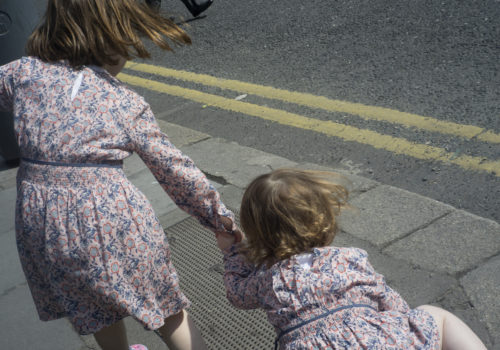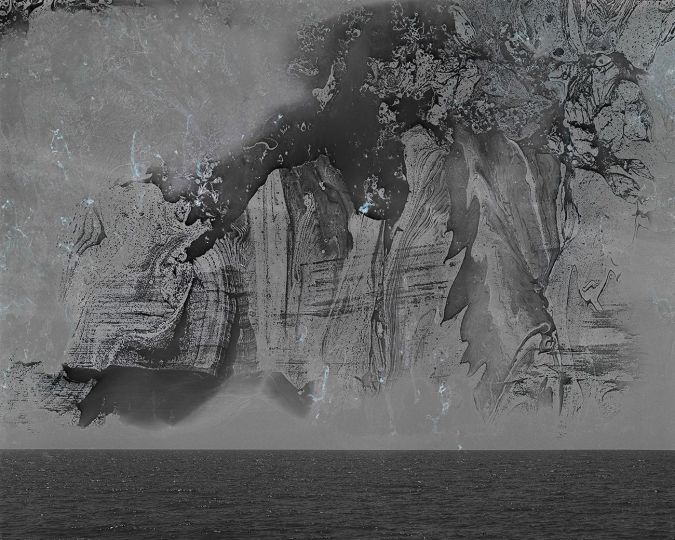The great discovery of the last Rencontres d’Arles, the Irish photographer Eamonn Doyle is showing his Dublin trilogy in a very different setting in Rouen at the Pôle Image Haute Normandie. An ambitious work that embodies, according to some critics, the revival of “street photography”, a rather hazy genre that we all thought was dead.
Since the dawn of photography, hundreds of photographers have taken shots in the street, but, for all that, does their work constitute a coherent genre? The term “street photography”, invented in the middle of the 20th century by specialists in art photography, would eventually only be devoted to a limited number of artists. If Walker Evans, Robert Frank, Helen Levitt, Ed Ruschka, Lee Friedlander or even William Klein, to name only the most famous, have unquestionably given “Street Photography” its noble credentials, this category, at the crossroads of several movements (documentary photography, artistic, photojournalism…) remains too soft to be really relevant.
While acknowledging that there is a form of photography that uses the streets as a privileged theatre, it fiercely resists any attempt to confine its labelling to a single template as Eamonn Doyle’s dissonant, brutal and beautiful images show. How to take account of our irreducible distance from The Other? This nagging question runs through the work of the Irish photographer, influenced by the imaginary melancholy of the writer Samuel Beckett. And it’s probably in the absence of any obvious response that the answer lies entirely in his approach.“My images only let you see fragments of the possible stories but to my eyes, all life has its share of theatricality even if, at the end of the day, its meaning escapes us,” he explained. It’s not surprising that he would have chosen the street where he lives as his testing ground. A restricted space that he visited endlessly throughout the days and the series ( i / On / End ). His images resemble life’s strange, trembling choreography, cheap music and soles scraping the bitumen. Silhouettes on the move, absorbed in the contemplation of an inaccessible, inner landscape, to others, seeing infinity as if time itself were unwinding.
Doyle likes the tight shots, the exaggerated viewpoints that give the bodies their particular density because as the exhibition’s curator, Raphaëlle Stopin explains, “With Doyle, as with Beckett, the body, or rather its presence, constitutes the primary means of expression and is unsurpassed by the being, and that supersedes all other ways of saying it, including the verb”. If the city most often reduces itself to a few element of scenery, it conceals a complex space in which both movement and duration move around each other, inside and out.Like Garry Winogrand before him, Eamonn Doyle seeks to establish a visual order in the chaos, to find a form that focusses on the mess in order for it to talk to him with the words of Samuel Beckett.
These affinities, more or less clearly made, with other great figures of street photography have made Winogrand a standard- bearer for a genre, the final shape of which has not yet been defined. Marta Gili, the director of the Jeu de Paume gallery, which showed an imposing retrospective of “the master of the snapshot” described it as a subjective documentary style, that takes the urban territory by storm with a mixture of spontaneity and irony, fascination and anxiety.
It’s a definition that doesn’t cast aside Robert Frank who instinctively rejected the bases of “street photography” by forging a new way of photographing, free, head-on, as close as possible to the depth of humanity. Not a graphical or narrative high point.For him the street is a mirror in which he desperately searches for his own reflection. Each one of his pictures bears the stamp of his own existence. If, for Frank, the “truth” imposes itself with evidence, for Winogrand it takes a more complex shape in which its tensions have a visual interpretation that, like the urban space itself, can escape neither its logic nor its absurdities.When he declared, recalling images taken on the fly: “I would prefer not to be there”, it was to underline how the presence of the photographer affects our perception of reality. What does seeing and being seen mean? Can the simple fact of looking create meaning? This paradigm shift is a work in progress in street photography.
His pictures, like those of Eamonn Doyle or Ethan Levitas, whose informal trilogy (Ten Year Study, In Advance of a Broken Arm, and Photographs in 3 Acts) we could also see last summer in Arles, have their own power of meaning and narrative, and emerge in the versatile flow of street stories as they evolve,but also as marks of history.
To give shape to that which is visible in the current political context of control and surveillance. That is the recurring theme for many photographers who, as Charles Beaudelaire wrote” chose to live in the world, in the undulations, in the movement, in the transitory and the infinite”.
Ethan Levitas, who continues Garry Winogrand’s traditions while broadening his practice of street photography gives perhaps the best definition “an intervention exploiting the power of the photographer”, power that he has conceptualized for a dozen years by exploring the multiple possibilities offered by the medium. “ it is not seeing but looking. And looking, in itself, is an intervention into reality… It is more or less the creation of another reality…And all of that is connected to what, at the same time, is in front of and behind the lens, in other words to the conditions of the eye.”
Cathy Rémy
Cathy Rémy has been a journalist at Le Monde since 2008. She aims to discover young photographers and emerging visual artists. Since 2011, she has contributed to M Le Monde, Camera and Aperture.
Eamonn Doyle : Dublin Trilogies
From October 15th 2016 to February 18th 2017
Centre Photographique
Pôle Image Haute-Normandie
15 rue de la Chaîne, 76000 Rouen
Free entry. Tuesday – Saturday 2.00pm – 7.00pm.

















